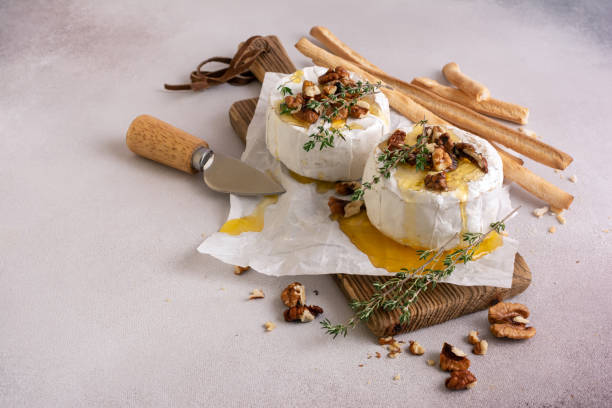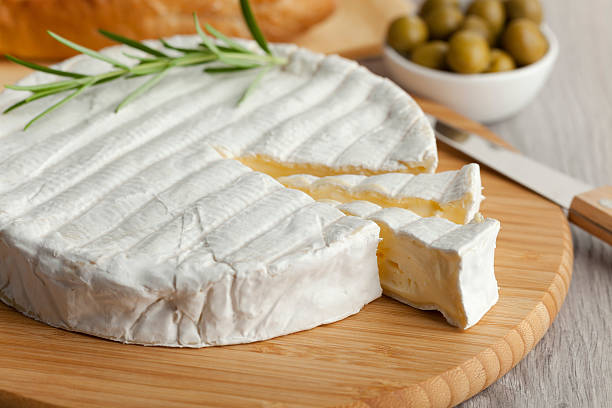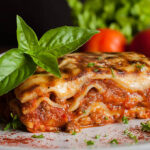Have you ever wondered why Brie cheese is so popular? Look no further – we’ve got all the answers for you right here. From its distinctive flavor profile to its versatility in both traditional and modern recipes, Brie cheese is an excellent choice for any occasion. In this blog post, we will explore how do eat brie cheese with tips on pairing it correctly as well as creative ways to savor every bite of this delicious dairy product.
Contents
Overview of Brie’s taste, texture, and aroma

Brie is a soft, white cheese with a rich, creamy texture and a subtle, earthy aroma. The rind is whitish, bloomy, and edible. The interior paste ranges from soft and creamy when young to semi-soft and oozy when perfectly ripe.
Brie has a smooth, buttery mouthfeel and a flavor profile described as mild, mushroomy, and nutty with notes of grass and cream. The rind contributes earthiness and complexity. The cheese gracefully transitions from mild at the center to robust at the edges.
Significance of Brie in French cuisine and its global popularity
Brie holds an esteemed status in French gastronomy and culture. It’s considered one of the great French cheeses, alongside Camembert and Reblochon. Brie emerged in the 8th century near Paris and was popularized under King Charlemagne.
Today, Brie’s velvety texture and nuanced flavor make it a global favorite. It frequents cheeseboards worldwide and elevates everything from appetizers to desserts. Brie also suits many cuisines, from French to Italian to Middle Eastern. Its approachable profile appeals to cheese novices and experts alike.
Origins and Varieties of Brie Cheese
Historical background and geographical origins of Brie cheese
Brie originated in the French regions of Brie and Meaux east of Paris. Its creation dates to the 8th century during the Carolingian era under Charlemagne’s reign. Monks likely experimented with cheesemaking using local ingredients, resulting in early Brie.
Brie achieved aristocratic status in the Middle Ages. French nobility prized the cheese and promoted its proliferation. Brie’s popularity flourished under Louis XVI in the late 18th century.
Introduction to different varieties of Brie
There are two main varieties of authentic French Brie certified with AOC status:
- Brie de Meaux hails from the Meaux region. It features a fine, bloomy rind and a rich, creamy interior with prominent mushroom flavors.
- Brie de Melun comes from the Melun area. It has a thicker, gray rind and a dense, crumbly texture with robust, woodsy notes.
Other noteworthy varieties include:
- Brie de Nangis: Smooth, delicate paste with a subtle aroma
- Brie de Montereau: Small, flaky texture with a discernible rind
- Brie noir: Brie made from pasteurized cow’s milk mixed with charcoal to blacken the rind
Preparing Brie for Serving
Tips on how to properly prepare Brie for consumption
To ready Brie for eating:
- Remove Brie from refrigeration 1-2 hours before serving to temper. Brie is best at room temperature.
- Cut off the top rind if desired, exposing the creamy interior. Keep some rind for added flavor.
- Slice Brie horizontally into wedges or vertically into triangular pieces. Avoid crumbling.
- When trimming and slicing Brie, use a sharp knife to prevent sticking. Wipe the knife clean between cuts.
- Transfer sliced Brie to a plate or board. Avoid puncturing the rind’s bloomy exterior before serving.
Serving Brie: Techniques and Presentation
Recommendations for presenting Brie, including cutting techniques and serving suggestions
Attractively display sliced Brie on a cheeseboard alongside fruits, nuts, chutneys, and crackers or bread. Furnish the board with elements like fresh grapes, figs, walnuts, and honey that pair well with Brie.
For receptions, assemble Brie en croûte – wrapped in puff pastry and baked until golden. Top with cranberry compote or fruit preserves for contrasting sweetness.
Slice baked Brie wheels into wedges for sharing. Provide spreads for guests to swipe the oozing cheese onto baguette slices.
For plated presentations, adorn dishes with Brie quenelles or triangles interspersed with carefully paired components.
Pairing with Brie Cheese
Detailed ideas for food and beverage pairings that enhance Brie’s
Light, fruity wines like Beaujolais, Riesling, and rosé balance Brie’s richness without overpowering its delicate profile. Sparkling wines like Champagne are also excellent pairings. Their effervescence cleanses the palate between creamy bites.
For beers, choose witbiers like Hoegaarden and blonde ales like La Chouffe – both offer complementary citrus notes. Cider makes another pleasing partner, enhancing Brie’s apple undertones.
Seasonal and occasional pairing suggestions for versatile Brie enjoyment
Spring: Pair with asparagus, artichokes, fresh peas, and berries. Rosé and lambic beers suit this seasonal produce.
Summer: Serve with stone fruits, melon, tomato salad, and basil. Opt for Sauvignon Blanc or wheat beers.
Fall: Match with apples, pears, figs, and crunchy vegetables. Pick Pinot Noir or brown ales.
Winter: Complement heartier fare like roasted squash, sautéed greens, and savory tarts. Try bold red wines and stouts.
Holidays: Spread on a cheeseboard with cranberries, nuts, and chutneys for festive flair.
Enjoying the Rind: A Flavorful Component
Encouragement and rationale for consuming Brie’s rind
Brie’s edible rind is packed with complex flavors and aromas that enhance the cheese. Enjoy the rind along with the interior paste for a full-sensory experience. The rind develops Brie’s signature earthiness through carefully cultivated mold growth.
Concerns about eating cheese rind often stem from wariness of mold or bacteria. However, Brie’s bloomy rind results from beneficial microbes that impart characteristic tastes. Properly aged rind poses no health risks. Still apprehensive? Start by sampling just a small amount of the rind with the creamy paste to acclimate your palate.
Storing Brie: Best Practices
Guidelines for properly storing leftover Brie to maintain its quality
Uncut Brie keeps for up to 10 days after purchase when refrigerated in its original packaging. Once cut, Brie will last 3-5 days refrigerated in an airtight container.
Wrap cut Brie in parchment then plastic wrap to minimize air exposure. Avoid aluminum foil as it can cause undesired oxidation.
Store Brie in the cheese drawer or vegetable crisper of your refrigerator. The slightly higher humidity in these areas prevents drying.
If Brie begins growing blue mold, trim off the affected area. Otherwise, when in doubt, remember the adage: “When it doubt, throw it out.” Discard Brie when it takes on an ammoniated smell or becomes excessively runny.
Selecting and Buying High-Quality Brie
Advice on choosing the best Brie at stores or markets
Seek out artisanal or AOC Brie for optimal flavor and quality assurance. Check the rind – it should be white, not browned, with a fuzzy coat of mold.
The rind may show some light cracking around the edges – a sign of a well-aged Brie. Avoid cheese with excessive cracking or dark brown mold.
Gently press the sides and center. Fresh Brie will feel firm yet pliable. As it ripens, it softens until oozy and spreadable at perfect maturity.
Discoloration of the interior paste indicates oxidation. Select Brie wheels with a smooth, creamy white center.
Smell the Brie. Ample earthiness and mushroom aroma signal complexity. Avoid ammonia-like odors.
Creative Ways to Incorporate Brie into Dishes
Innovative recipes and ideas for using Brie in various culinary contexts
- Stuff mushroom caps with Brie, herbs, and breadcrumbs then bake until hot and melty.
- Mix Brie into risotto along with sautéed leeks and peas.
- Swirl Brie into fluffy omelets or scrambled eggs.
- Layer Brie, prosciutto, and fig jam on panini or flatbread and grill to perfection.
- Fold diced Brie into waffle or pancake batter just before cooking.
- Blend Brie with roasted garlic and olive oil into a rich, decadent soup.
- Mix crumbled Brie into macaroni and cheese for an elegant twist.
- Top naan or crostini with chutney, Brie slices, and roasted pears or apples.
Health, Nutrition, and Dietary Considerations
Discussion of Brie’s health benefits, nutritional content, and considerations
Brie offers health upsides like protein and calcium. As a fermented food, it contains probiotics that aid digestion. However, Brie is high in saturated fat and sodium, so enjoy in moderation.
Per 1 oz serving, Brie provides 98 calories, 8g fat (5g saturated), 7g protein, trace carbs, and 201mg sodium.
Brie is a good option for vegetarian, gluten-free, and paleo diets when procedural standards are met. Always verify certifications for specialty dietary restrictions like vegan or kosher.
People with lactose intolerance can often enjoy small servings of harder cheeses like Brie since lower lactose levels result from the aging process.
Cultural Significance and Global Adoption
Exploration of Brie’s role in French culture and its influence on international cuisines
In France, Brie epitomizes the cultural ideal of terroir – the interplay between locality, soil, climate, and craft. Brie cheese and the surrounding Brie region share an identity.
Brie emerges from a long tradition of French cheesemaking passed down generations. It remains an exemplar of France’s culinary heritage.
As Brie gained acclaim worldwide, countless nations integrated it into their own cuisines. Its popularity reinforces the notion of cheese as a universal language that transcends cultures.
Today discerning cheese connoisseurs agree: no cheeseboard or cheese course feels complete without a creamy wedge of Brie.
Common Mistakes to Avoid When Eating Brie

- Skipping the ripening process – Brie needs time for flavors to develop
- Refrigerating at too cold a temperature – Causes Brie to firm up
- Cutting the rind off completely – Removes delicious complexity
- Pairing Brie with overly tannic wines – Overpowers Brie’s subtlety
- Serving ice cold right out of the fridge – Suppresses aromas
- Storing in plastic wrap alone – Promotes excess moisture
- Keeping leftovers too long – Trust your senses to determine freshness
- Cooking with low-quality Brie – Inferior cheese detracts from any dish
- Overlooking the rind – Embrace the earthy richness it provides
Environmental and Ethical Considerations in Brie Production
Insight into sustainable practices and ethical considerations in the production of Brie cheese
Many traditional French Brie producers employ sustainable practices:
- Allowing cows to graze freely on pasture grasses
- Using local, non-GMO feed when grazing isn’t possible
- Limiting herd sizes to maintain quality
- Employing regenerative agriculture to enrich soil
However, large-scale Brie makers sometimes cut corners, harming animal welfare and the environment. When buying Brie, choose brands that source milk from humanely treated cows and practice ethical, eco-friendly production. Support smaller producers adhering to time-honored techniques.
FAQs About Brie Cheese
How long does Brie last after being opened?
Once opened, Brie will last 3-5 days properly stored in the refrigerator. Wrap cut Brie in parchment paper followed by plastic wrap or an airtight container.
Can you freeze Brie cheese?
Brie can be frozen but will suffer textural changes making it less creamy. Thaw frozen Brie overnight in the fridge before serving.
Is it safe to eat the rind on Brie?
Yes, Brie rind is edible. Its bloomy white rind results from harmless mold growth intentionally cultivated to impart flavor. Enjoy the rind and paste together.
What is the best wine to pair with Brie?
Brie pairs beautifully with light, fruity wines like Beaujolais, Riesling, and rosé. The crisp acidity and fruit notes balance Brie’s richness. Sparkling wines like Champagne also make excellent pairings.
Can you eat Brie while pregnant?
Unpasteurized Brie should be avoided during pregnancy as it could harbor harmful listeria bacteria. Pasteurized Brie is safer but should still only be consumed fully cooked or baked. Check labels and heat Brie to 165°F for food safety.
Conclusion
Brie offers the quintessential soft, creamy cheese experience with subtle earthy notes and a signature bloomy rind. Sliced Brie beautifully crowns a cheeseboard, pairs elegantly with wine, and elevates everything from appetizers to desserts. Experiment with baking en croûte or incorporating into dishes. Follow a few simple guidelines for buying, storing, and serving, and luscious Brie will delight cheese aficionados and novices alike. The French have treasured this cheese for centuries – with one taste, you’ll immediately understand why.

At the age of 25, chef and owner Michael Scognamiglio opened with confidence Bacco Italian restaurant.







